Sports fans and gadget freaks can follow their favourite major league teams and top international athletes in new high-tech ways, if they have the right gear in hand – or on their head.
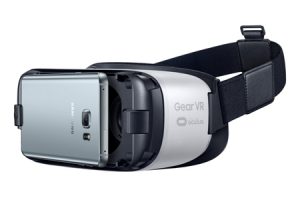
The Samsung Gear VR is a mobile virtual reality headset developed by Samsung Electronics, in collaboration with Oculus, and manufactured by Samsung.
Virtual reality is the latest craze to sweep the digital media delivery landscape, and entertainment, documentary and especially live sports VR content is becoming easier to find and easier to watch.
NASCAR auto racing, NBA basketball, pro golf and other sports have already been covered in virtual reality, and coming later this summer, the ultimate sports event will receive the same high-tech treatment – the Olympic Games in Rio de Janeiro.
The International Olympic Committee, its Olympic Broadcast Services (OBS) production arm, and the rightsholder here in Canada, CBC/Radio Canada, are getting ready to deliver up to 100 hours of Olympic coverage as live virtual reality (VR) and 360-degree video streams.
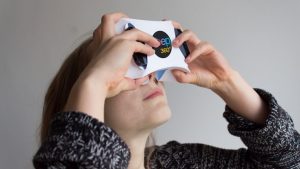
Paper and cardboard versions of a VR headset are distributed with certain apps; instructions for do-it-yourself homemade versions are easy to find.
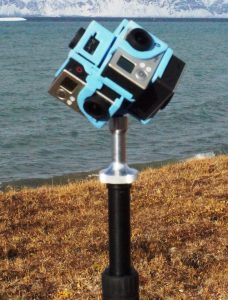
360-degree video camera rigs like those used for television documentary-making in Canada’s Arctic (see https://polarsea360.arte.tv/) can also be used for live TV sports.
(To create VR sequences, multiple cameras – or a single camera with multiple lenses – are sync’ed up, and special software is used to stitch video scenes together so an immersive, full-surround visual environment can be created. That virtually real space is then delivered to viewers on their flatscreen tablet or smartphone – with on-screen navigation controls – or on their wearable headset with built-in dual displays for stereoscopic viewing.)
No one says the streams are a substitute for actually attending the 2016 Rio Summer Olympics, or for full screen TV viewing, but Olympic broadcast organizers are satisfied that virtual reality technology has matured enough, and audiences have grown in interest and size, to the point they are now executing a dedicated Rio VR video project.
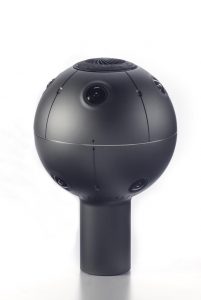
360-degree cameras and VR camera systems will be deployed at the Rio Olympics.
As the CBC gears up to carry the OBS VR feeds, producers at the public broadcaster are anticipating unique in-venue camera placements and in some cases multiple camera/angle feeds from which the end viewer can choose. There will be three VR camera systems moving from venue to venue plus a wireless system that can move around inside some venues. OBS is working with a third-party service provider to produce the VR content.
The content will be streamed live, in real time. Video content will also be available as highlights the following day.
Feeds will be available for iOS and Android devices through a dedicated app and traditional Web offerings. Of course, the experience differs depending on the device that’s used: with a VR headset, a fully immersive view can be chosen to give the full 3D/360 experience in the binary-scopic view. Tablet or mobile users get a 360-degree motion-sensitive view.
CBC adds that a lot of work is being done to try and deliver a consistent experience across multiple devices and different mobile systems, but challenges partly due to proprietary engineering in some operating system software must be overcome; CBC and OBS say they are making progress on the issues.
Broadcasters know VR technology is still far from the mainstream, yet it has incredible potential for sportscasting (and other applications) with its immersive, you-are-there impact that makes the viewer feel as if they are closer to the action than ever before, even if they are thousands of miles away.
As happened when high-definition began to replace standard definition TV, broadcasters and sports content providers must invest wisely in a new technology like VR, as the number of users is so small that the mass appeal may not have gelled as yet. CBC/Radio-Canada says it’s out front in this instance knowing that VR is a hot topic in the entertainment and sport industry, although its use does raise those questions of value of innovation and the value to the mass audience.
FOX Sports is out there, too: the U.S. broadcaster recently inked a major media deal with NextVR, a leader in the production of VR content and technology. Their VR coverage of the recent U.S. Open golf tournament, for example, had special cameras set up at specific holes and locations on the course, so that both live and pre-packaged VR content could be delivered to connected devices, along with the more comprehensive regular TV coverage.
The coverage was available through a dedicated NextVR app for Samsung Gear VR owners.
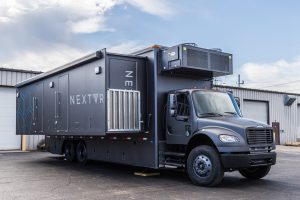
The NextVR production truck is designed so it can pull up to any venue and begin producing live multi-camera, stereoscopic VR programs with fully mixed 3D VR audio right away.
NextVR has, in fact, launched its own VR production truck, a fully outfitted vehicle that travels from event to event to provide immersive, 360 and virtual reality content.

TSN Sportscentre Gets the 360-video, VR treatment.
Meanwhile, Canadian sports specialty service TSN recently indulged in its first VR experience, with a short 360-degree segment that immerses viewers in the Sportscentre TV studio and production environment.
In this case, a dedicated YouTube app lets users navigate the video scenes on-screen. TSN produced the VR video working with Montreal-based video game studio Minority Media.
Particularly in the case of the VR Olympics, but right across the board, producers are taking a close look at which different virtual reality production styles and delivery technologies are most successful, based on daily analytics on video views, unique views, session time, device and locality breakdown data that can be gathered.
-30-



